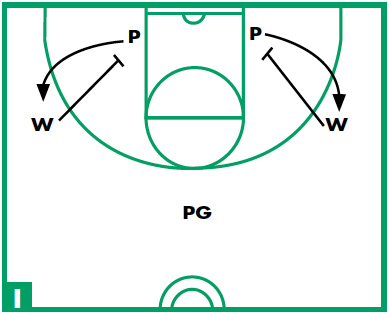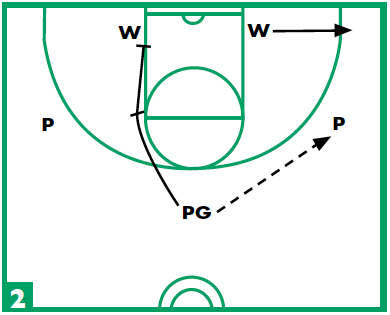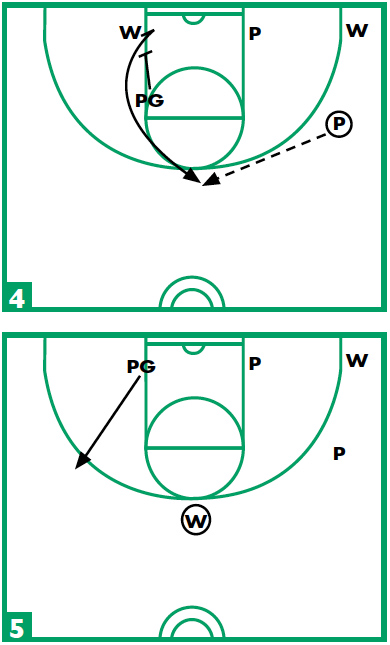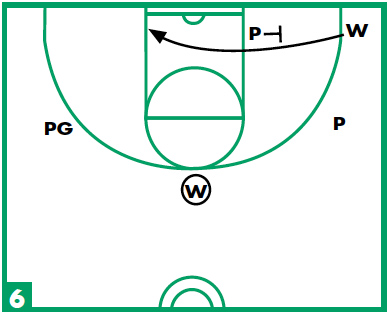Running the ‘Modified Flex Offense’
The Modified Flex Offense is a twist on one of the most-used offenses in basketball. By running this offense, you have the opportunity for motion while not relying on a superstar player for all your offensive output.
The “twist” comes in the court balance of the players. There are five key teaching points to this offense:
- Spacing (top of the key, wings and blocks).
- Screening (head-hunting).
- Cutting (fake opposite first).
- Passing (to the outside hand for offensive execution and to the inside hand for scoring).
- Timing.
Modified Flex Offense
 DIAGRAM 1: Modified Flex (A). The point guard (PG) starts with the ball at the top of the set. Both wings (W) move down toward the blocks to screen for the two post (P) players. As the wings come down, the posts fake a movement toward the hoop for a lob to freeze the defense. This fake provides enough time for the wings to head-hunt and place a solid screen on each post player’s defender.
DIAGRAM 1: Modified Flex (A). The point guard (PG) starts with the ball at the top of the set. Both wings (W) move down toward the blocks to screen for the two post (P) players. As the wings come down, the posts fake a movement toward the hoop for a lob to freeze the defense. This fake provides enough time for the wings to head-hunt and place a solid screen on each post player’s defender.
If the posts are not open coming off the screen, they have the option to screen back down for the wing player. This process is repeated until someone comes free on the wing. The PG does not pick up the ball until there is an open pass to the wing or an open lob in the post.
 DIAGRAM 2: Modified Flex (B). When a pass is made to a player on the wing, that player utilizes an inside pivot foot, gets into triple-threat position, pump fakes and jab steps to keep the defense off-balance. The player in the strong-side post clears to the corner. The PG passes to P, then moves into the lane to set two screens as shown in the next two diagrams.
DIAGRAM 2: Modified Flex (B). When a pass is made to a player on the wing, that player utilizes an inside pivot foot, gets into triple-threat position, pump fakes and jab steps to keep the defense off-balance. The player in the strong-side post clears to the corner. The PG passes to P, then moves into the lane to set two screens as shown in the next two diagrams.
 DIAGRAM 3: Modified Flex (C). The PG’s first screen is set for the player on the weak-side wing. That chip screen is set by the PG just below the weak-side elbow. A chip screen is when the player sets a screen to run off his or her shoulder with the screener standing sideways rather than taking the screen in the chest.
DIAGRAM 3: Modified Flex (C). The PG’s first screen is set for the player on the weak-side wing. That chip screen is set by the PG just below the weak-side elbow. A chip screen is when the player sets a screen to run off his or her shoulder with the screener standing sideways rather than taking the screen in the chest.
P cuts off the screen to the strong-side block while providing a target for a possible pass from the P on the wing.
» ALSO SEE: Toughness drills to build team character
 DIAGRAM 4: Modified Flex (D). The PG’s second screen takes place near the weak-side block. The player on the block sets up the defender with a fake movement toward the goal, then running his or her defender into the screen set by the PG.
DIAGRAM 4: Modified Flex (D). The PG’s second screen takes place near the weak-side block. The player on the block sets up the defender with a fake movement toward the goal, then running his or her defender into the screen set by the PG.
This cutter runs to the free-throw line for a potential jump shot. If the cutter doesn’t have an open shot, he or she moves to the top of the set for a pass from the player on the wing. This keeps the offense moving.
DIAGRAM 5: Modified Flex (E). The PG, who is now on the left block, clears to the left-side wing to make room for the upcoming “flex cut.”
 DIAGRAM 6: Modified Flex (F). The “flex cut” is run by the W who originally cleared to the strong-side corner. This W now runs off a screen by the player on the block. W either fakes high, then cuts below the screen or vice versa.
DIAGRAM 6: Modified Flex (F). The “flex cut” is run by the W who originally cleared to the strong-side corner. This W now runs off a screen by the player on the block. W either fakes high, then cuts below the screen or vice versa.
Either way, W stops for a second in the lane, calls for the ball and looks for a pass to score. If W is not open, W continues to the other block and your offense is balanced again.









